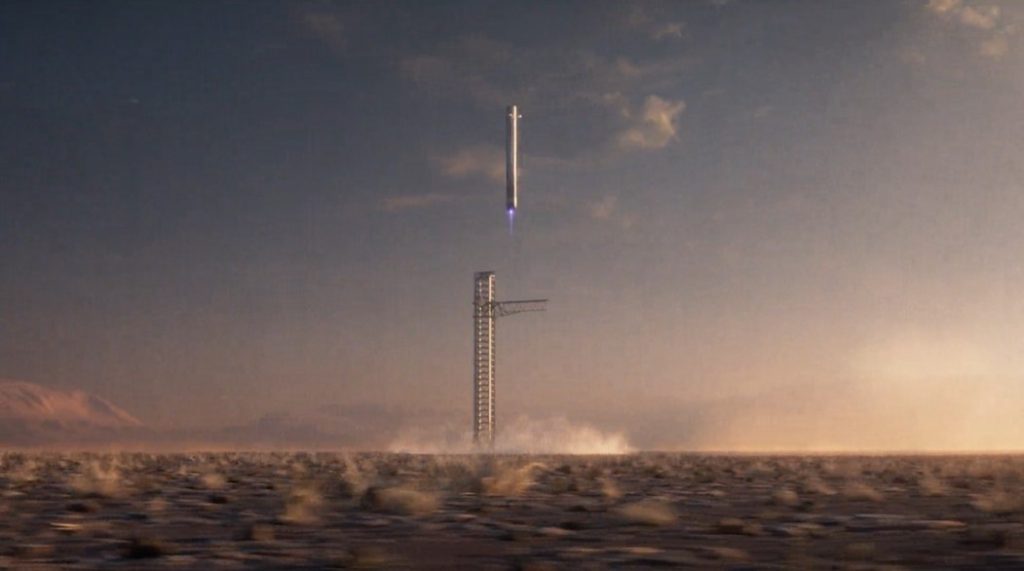
Chinese launch startup Cosmoleap secures funding for rocket featuring chopstick recovery system (Image Credit: Space News)
HELSINKI — Chinese launch firm Cosmoleap has secured more than 100 million yuan for the development of its Yueqian reusable rocket and a recovery system inspired by SpaceX.
Cosmoleap announced more than $14 million in funding Nov. 1. Shenergy Chengyi, a Shanghai-based state-owned enterprise focusing on innovative investments, Tiangchuang Capital, an investment firm with a focus on emerging technologies, venture capital firm Baiyan Fund, Legend Capital, a venture capital firm supporting technological advancements, and investor Zhang Chao participated in the funding round.
Cosmoleap, full name Beijing Dahang Transition Technology Co., Ltd., announced its existence and start of operations in March 2024. The company focuses on developing a low-cost, high-reliability, reusable launch vehicle. The goal is to “support satellite Internet construction,” likely referring to China’s megaconstellation plans.
It aims to hold a test flight of the “Yueqian” or “Leap” rocket in either 2025 or 2026. An animated video with the funding announcement indicates that the company is following a tower and “chopstick” landing method recently demonstrated for the first time by SpaceX with its Starship system.
The Yueqian methane-fueled rocket will, however, be much smaller. It will have a 4.0 meter diameter and length of 75 meters. Its payload capacity to a 1,000 km altitude orbit for constellation purposes will be 10,460 kilograms when expendable, or 6,280 kg when the first stage is recovered.
The company also plans a 126-meter-long rocket, capable of carrying 100 tons to the same orbit when expended, or 36 tons when reused. The first launch is targeted for around 2030.
Cosmoleap investors stated their beliefs that the company can benefit from the commercial space supply chain built across 2015-203, while also making the most of latecomer advantage.
The company enters a field already inhabited by commercial entities Landspace, Galactic Energy, Space Pioneer, iSpace and Deep Blue Aerospace among others, state-owned spinoffs CAS Space and Expace, as well as reusable Long March rockets being developed by CASC.
A Cosmoleap representative made a presentation at the recent International Astronautical Congress in Milan, Italy. Apparently inconsistent with its apparent start of operations, the presentation abstract states that the medium-sized reusable commercial launch vehicle has, “following three years of detailed design and extensive ground testing,” a first flight scheduled for 2025.
China’s central government has designated commercial space as a strategic emerging sector and noted it as a priority. Chinese provinces and cities are developing action plans to attract and nurture space companies and clusters.
| Company | Rocket Name | Rocket Type | Key Features/Notes |
|---|---|---|---|
| iSpace | Hyperbola-3 | Methane-liquid oxygen | Payload capacity of 8,500 kg to Low Earth Orbit (LEO); first flight planned for 2025. |
| Landspace | Zhuque-3 | Methalox | Payload capacity up to 21,000 kg to LEO. Stainless steel. First flight planned for 2025. |
| Galactic Energy | Pallas-1 | Kerosene-liquid oxygen | Payload capacity of 5,000 kg to LEO, or 3,000 kg to a 700 km sun-synchronous orbit (SSO). |
| CAS Space | Kinetica 2 | Kerolox | Payload capacity of 7,800 kg to 500 km SSO. |
| Deep Blue Aerospace | Nebula-1 | Kerolox | Payload capacity of 1,000 kg to 500 km SSO; 2,000 kg to LEO. First flight planned in late 2024. |
| Space Pioneer | Tianlong-3 | Kerolox | Comparable to Falcon 9 in launch capability; plans for a reusable first stage. |
| Space Epoch | XZY-1 | Methalox | 7,000 kg to 1,100 km. Stainless steel. First flight in 2025. |
| Orienspace | Gravity-2 | Kerolox | 25,600 kg to LEO. First flight in 2025; plans for a reusable first stage. |
| CASC | Various | Various | Working on reusable rockets including a new-generation human-rated launcher, spaceplane, and Long March 9 super heavy-lift launcher. |
| Cosmoleap | Leap | Methalox | 10,460 kg to 1,000 km when expendable, or 6,280 kg when the first stage is recovered. Features a “chopstick-style” tower recovery system; first flight in 2025 or 2026. |








